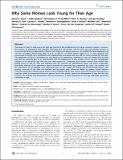Files in this item
Why some women look young for their age
Item metadata
| dc.contributor.author | Gunn, D.A. | |
| dc.contributor.author | Rexbye, H. | |
| dc.contributor.author | Griffiths, C.E.M. | |
| dc.contributor.author | Murray, P.G. | |
| dc.contributor.author | Fereday, A. | |
| dc.contributor.author | Catt, S.D. | |
| dc.contributor.author | Tomlin, C.C. | |
| dc.contributor.author | Strongitharm, B.H. | |
| dc.contributor.author | Perrett, David Ian | |
| dc.contributor.author | Catt, M. | |
| dc.contributor.author | Mayes, A.E. | |
| dc.contributor.author | Messenger, A.G. | |
| dc.contributor.author | Green, M.R. | |
| dc.contributor.author | van der Ouderaa, F. | |
| dc.contributor.author | Vaupel, J.W. | |
| dc.contributor.author | Christensen, K. | |
| dc.date.accessioned | 2013-12-02T09:31:02Z | |
| dc.date.available | 2013-12-02T09:31:02Z | |
| dc.date.issued | 2009 | |
| dc.identifier | 5335300 | |
| dc.identifier | 64e1ccb2-fd87-48f9-9bf0-9dd0c9af1b76 | |
| dc.identifier | 77954010574 | |
| dc.identifier.citation | Gunn , D A , Rexbye , H , Griffiths , C E M , Murray , P G , Fereday , A , Catt , S D , Tomlin , C C , Strongitharm , B H , Perrett , D I , Catt , M , Mayes , A E , Messenger , A G , Green , M R , van der Ouderaa , F , Vaupel , J W & Christensen , K 2009 , ' Why some women look young for their age ' , PLoS One , vol. 4 , no. 12 , e8021 . https://doi.org/10.1371/journal.pone.0008021 | en |
| dc.identifier.issn | 1932-6203 | |
| dc.identifier.other | ORCID: /0000-0002-6025-0939/work/64360992 | |
| dc.identifier.uri | https://hdl.handle.net/10023/4229 | |
| dc.description | Both studies were funded by Unilever PLC (http://www.unilever.com/). Some of the authors are employed by Unilever PLC and were involved in the design, data collection and analysis as well as the decision to publish. | en |
| dc.description.abstract | The desire of many to look young for their age has led to the establishment of a large cosmetics industry. However, the features of appearance that primarily determine how old women look for their age and whether genetic or environmental factors predominately influence such features are largely unknown. We studied the facial appearance of 102 pairs of female Danish twins aged 59 to 81 as well as 162 British females aged 45 to 75. Skin wrinkling, hair graying and lip height were significantly and independently associated with how old the women looked for their age. The appearance of facial sun-damage was also found to be significantly correlated to how old women look for their age and was primarily due to its commonality with the appearance of skin wrinkles. There was also considerable variation in the perceived age data that was unaccounted for. Composite facial images created from women who looked young or old for their age indicated that the structure of subcutaneous tissue was partly responsible. Heritability analyses of the appearance features revealed that perceived age, pigmented age spots, skin wrinkles and the appearance of sun-damage were influenced more or less equally by genetic and environmental factors. Hair graying, recession of hair from the forehead and lip height were influenced mainly by genetic factors whereas environmental factors influenced hair thinning. These findings indicate that women who look young for their age have large lips, avoid sun-exposure and possess genetic factors that protect against the development of gray hair and skin wrinkles. The findings also demonstrate that perceived age is a better biomarker of skin, hair and facial aging than chronological age. | |
| dc.format.extent | 6392493 | |
| dc.language.iso | eng | |
| dc.relation.ispartof | PLoS One | en |
| dc.subject | Aging | en |
| dc.subject | Genetic factors | en |
| dc.subject | Environmental factors | en |
| dc.subject | Facial appearance | en |
| dc.subject | Skin aging | en |
| dc.subject | Perceived age | en |
| dc.title | Why some women look young for their age | en |
| dc.type | Journal article | en |
| dc.contributor.institution | University of St Andrews. School of Psychology and Neuroscience | en |
| dc.contributor.institution | University of St Andrews. Institute of Behavioural and Neural Sciences | en |
| dc.identifier.doi | https://doi.org/10.1371/journal.pone.0008021 | |
| dc.description.status | Peer reviewed | en |
This item appears in the following Collection(s)
Items in the St Andrews Research Repository are protected by copyright, with all rights reserved, unless otherwise indicated.

